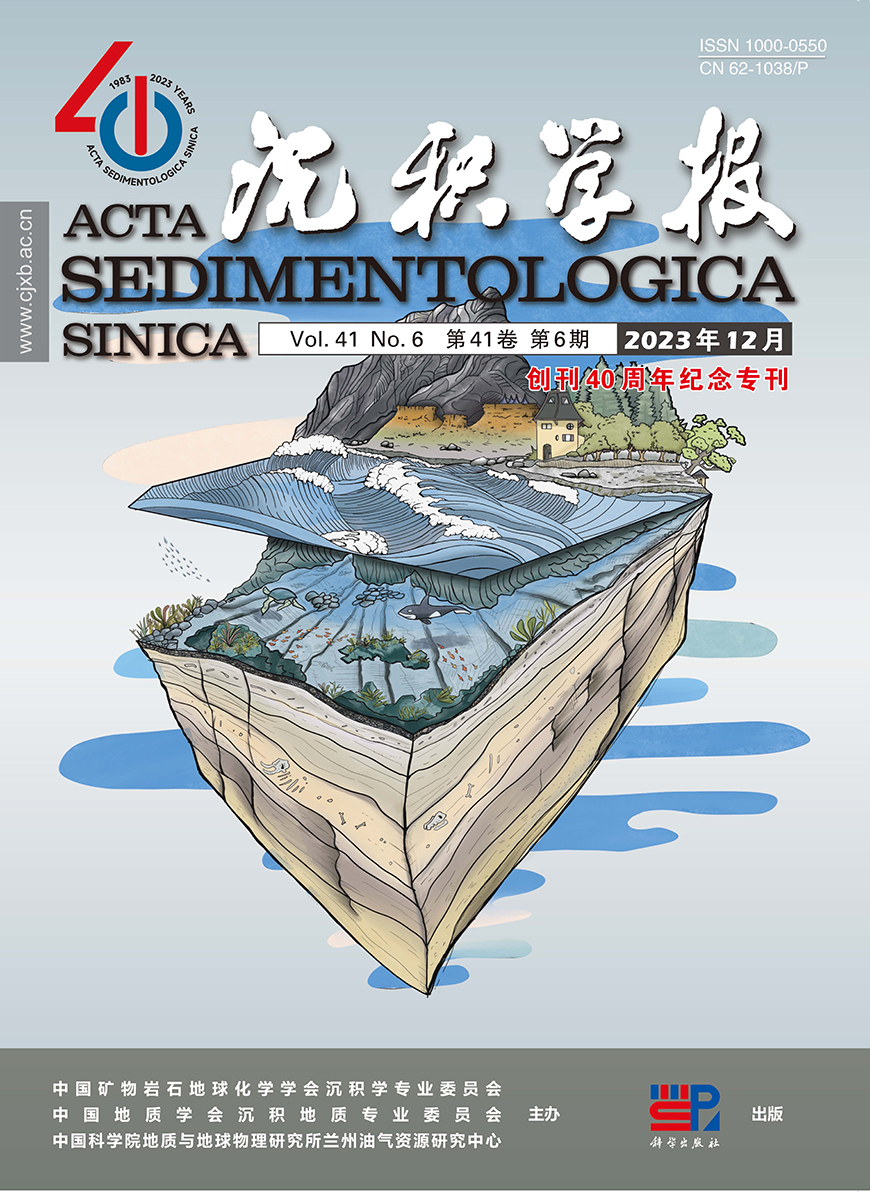HTML
-
日本海是西北太平洋的一个半封闭的边缘海,处在东亚季风区,属于温带海洋性季风气候,同时也受西风带影响[1⁃3]。日本海有着十分特殊的地理位置和水文特征,因其具有大洋特征的环流系统(如亚极地锋、西边界流和深层水形成等)而被称为微型大洋[4⁃6]。日本海的古海洋环境敏感地响应于晚新生代日本海周边的构造活动(如日本岛弧隆起和海槛形成演化)、东亚季风和黑潮演化、北太平洋深层水(NPDW)形成、全球气候及海平面变化等,因此其沉积物中蕴含着丰富的古海洋信息[7⁃8]。而且,日本海接受了大量来自亚洲内陆的风尘及日本岛河流沉积物,其沉积记录对于重建东亚大陆新生代的古气候演化,也有着重要的意义[8⁃12](图1)。自20世纪70年代开始,日本海开展了一系列的国际大洋钻探计划:包括深海钻探计划(DSDP)31航次(1973年)、以构造为主题的国际大洋钻探计划(ODP)127和128航次(1989年),聚焦于季风气候演化的国际综合大洋钻探计划(IODP)346“亚洲季风”航次(2013年)。其中,IODP 346航次的科学目标是探索大气、降水和海洋过程之间的相互关系,而表层生产力演化的重建正是其中的一个重要方面[10]。
海洋表层生产力及其生物泵过程是海洋碳循环的关键环节,连接着大气碳库和海洋碳库[13]。海洋浮游植物贡献了地球上约50%的光合作用,并通过控制大气CO2浓度来调节地球气候[14]。海洋表层浮游植物主要包括钙质和硅质浮游植物,其中硅藻的固碳效率显著高于钙质浮游植物,硅藻贡献了约40%的海洋初级生产力[15]。在边缘海中,现今日本海具有较高的初级生产力(191~222 g C/m2/yr),pCO2为-0.3~-2.2 mol/m2/yr,吸收了大量人类来源的CO2,是一个净的碳汇[16⁃19]。日本海内部溶解的无机碳含量明显高于大洋,其主要由有机质分解而非CaCO3溶解提供,郁陵海盆是目前日本海碳循环研究程度最高的区域,现今郁陵海盆平均的有机碳(TOC)埋藏通量约为1.75±0.25 molC/m2/yr[6]。而在IODP 346航次从日本海取得的沉积物岩心中,存在着大量硅藻化石(20%~70%)且富含有机碳(0.4%~4.9%),有机碳埋藏通量为0.48~17.2 molC/m2/yr[10,20⁃21]。这指示了当时日本海表层海水维持着较高的生物生产力,反映日本海长期具有高的有机碳埋藏效率[10]。不断出现的诸多科学假说,如“铁假说”[22]、“硅假说”[23]、“碱度泵假说”[24⁃25]、“硅溢漏假说”[26⁃28]以及“硅藻与颗石藻比例对大洋碳储库的影响”[29]等,均表明硅藻在古气候演化中有着重要的作用。近年的研究还指出,风尘刺激硅藻勃发而后形成硅藻席沉积,可能是冰期大气pCO2降低的一个重要机制[30]。
在温室效应加剧的今天,人类已计划采取“地球工程学”的相关措施来应对全球变暖[31]。其中,“铁施肥”便是依据“铁假说”开展的,通过人为向大洋施加铁来刺激表层生产力,加强生物泵效应,从而增强碳埋藏[22,32⁃33]。但是,铁施肥的实际作用以及其对海洋生态的潜在负面影响,仍需要进一步评估[14,31,34⁃35]。“铁假说”主要是基于轨道时间尺度(冰期—间冰期)的证据[36⁃39],也得到了现场Fe施肥实验及相关模型的支持[32⁃34,40⁃41]。比如,过去70万年的冰期—间冰期旋回中,风尘铁的输入显著影响着西菲律宾海的古生产力;赤道太平洋的研究也表明,在过去1 Ma的冰期旋回中,风尘铁的输入和生物硅的埋藏有着明显的联系[38]。但是,“铁假说”也存在一定争议。一方面,冰期时风尘通量增加,带来更多的营养盐,从而促进表层初级生产力提升[32,36⁃37];但另一方面,冰期海冰扩张且海水层化加剧,水体垂直交换以及上升流减弱,又会使得营养盐上涌减少,导致表层的初级生产力降低[42⁃46]。此外,也有一些研究并不支持“铁假说”。例如,南大洋铁施肥实验(Southern Ocean Iron Release Experiment,SOIREE)虽然短期内刺激硅藻生产力勃发,但反而降低了碳输出速率[14]。当亚南极模态水供应到赤道太平洋的营养盐减少时,冰期时高的风尘通量并没有增强赤道太平洋的初级生产力[47⁃50]。
在构造时间尺度,西太平洋风尘沉积长期演变特征及机制方面的研究程度甚低,而在风尘长期输入对大洋生产力及全球碳循环潜在影响方面尤其不清楚[51⁃52]。晚中新世(12 Ma)以来,日本海处在硅藻的大量沉积期,具有高的初级生产力和有机碳埋藏[10,20⁃21]。而这一时期,也正对应于全球气候的明显变冷以及风尘通量的显著增加[53⁃60],暗示两者可能存在一定联系。但也有研究认为,新生代气候变冷,底层水温度降低及沉积速率增加,这有利于硅藻化石的保存,从而反映了硅藻化石丰度和表层生产力高低没有必然联系[61]。目前,日本海古生产力的研究主要集中在晚第四纪,尤其是末次冰期以来[62⁃66],更长的构造时间尺度的古生产力研究较少[7,20⁃21,67]。那么在构造时间尺度,日本海的古生产力如何响应于区域及全球变化?此外,日本海形成以来,风尘、火山活动等自然过程的铁施肥如何影响日本海的古生产力?探究这些科学问题,将有助于进一步理解地球的气候系统和碳循环,也可以检验“铁假说”等科学猜想在更长时间尺度的作用,从而有利于解决相关的科学争议,并为应对当今的全球气候变化提供新的启示。
-
日本海位于西北太平洋边缘,海域总面积约为101×104 km2,日本海由北部的日本海盆、东南部的大和海盆和西南部的郁陵海盆共同组成[5,10](图1)。日本海平均水深为1 350 m,其中日本海盆水深为3 000~3 700 m,大和海盆水深为2 000~2 900 m,郁陵海盆水深在2 000~2 500 m[7,68]。日本海通过对马海峡与东中国海相连,以津轻海峡与北太平洋相连,东北部则由宗谷海峡和鞑靼海峡与鄂霍次克海相通(图1)。现今由于这些海峡狭窄且浅,最大海槛深度仅约130 m,使得日本海与其他海域的水体交换十分有限[7]。
对马暖流(Tsushima Warm Current,TWC)是现今流入日本海的最重要洋流,它是自冲绳海槽北端向北穿越对马海峡的黑潮分支,为日本海提供了低纬热量和大量营养盐,向日本海表层海水(<200 m)提供了约55%的磷酸盐和67%的硝酸盐[7,69⁃71]。对马暖流进入日本海后分为三支,其中两个支流分别沿着本州岛西侧的内陆架和外陆架向东北方向流动,第三个支流则沿着朝鲜半岛的东部边缘向东北方向移动[10](图1)。从对马海峡进入的海水大部分经由津轻海峡进入北太平洋,部分通过宗谷海峡和鞑靼海峡进入鄂霍次克海[5]。日本海的表层水因对马暖流进入而具有高的盐度,在冬季的日本海北部冷却,从而形成了被称为“日本海特征水”的深层水[7,72⁃74]。日本海特征水具有极高的溶解氧含量(>220 μmol/kg)、较低的盐度(34.1‰)、均一的低温(约0 ℃)以及短的滞留时间(约300年)[75⁃77]。现代日本海并非Fe限制的高营养盐低叶绿素(High Nutrient and Low Chlorophyll,HNLC)区域[33],这可能是因为亚洲风尘及黑潮带来了富铁的物质[78⁃79]。日本海是低营养盐海域,这里的浮游植物受到氮、磷和硅的限制[32,78⁃79]。对马暖流和朝鲜半岛沿岸的上升流输送的溶解无机氮维持着日本海南部的初级生产力[70]。此外,秋冬季节,日本海沿岸发育风生上升流;在夏季台风时期,日本海偶尔存在上升流活动[80]。风生上升流区域提供了较多的溶解硅酸盐,有利于硅质浮游生物的生长[9,34]。
然而,日本海第四纪以前的古海洋环境与现在显著不同。从中中新世到晚上新世,日本海的表层流主要受到从津轻海峡等北侧海峡流入的北太平洋冷水的影响,由于南部对马海峡的几乎关闭,日本海偶尔受到暖水侵入的影响[81⁃85](图2a~c)。相反,在2 Ma以后,由于冲绳海槽张开和对马海峡变宽等因素的共同作用,日本海开始受到向北运动的对马暖流的显著影响[67,86](图2d)。与此同时,由于日本海北侧海峡逐渐变窄变浅,从北侧海峡侵入日本海的太平洋冷水对日本海的影响大幅下降[7,82](图2d)。而第四纪时期海平面的频繁变化,影响着冰期—间冰期旋回中日本海的底层水环境以及沉积物特征[7,9]。冰期时海平面较低,日本海也几乎是封闭的,可能因为淡水过多的输入超过了蒸发量,使得表层水盐度降低[62],这时海水层化不利于水体的垂直交换,限制的营养盐条件使得初级生产力降低[63,65,87]。而在晚第四纪(末次冰期)85~27 ka,对马暖流没有进入日本海;27~20 ka,黄河淡水的注入使得日本海水体层化;20~10 ka期间,亲潮(Oyashio Current,OC)开始通过津轻海峡进入日本海[62];约10 ka时对马暖流再次流入日本海[62,88]。后续研究也证实,40~24 ka的低海平面时期,对马暖流消失;现代对马暖流的发育始于16 ka左右,最终形成于约8.5 ka[89]。在6.5 ka左右,日本海便确立了如今的环境特征[90]。此外,除了对马暖流、东海沿岸水和亲潮,在构造时间尺度,北太平洋最低含氧带(Oxygen Minimum Zone, OMZ)水体乃至NPDW等深层水体也会影响日本海的古海洋环境[7,20,58,91]。
-
日本海张开于晚渐新世时期(约28 Ma),在中中新世(约15 Ma)结束扩张,在大约10 Ma受到挤压的影响,并最终于第四纪早期形成了初始的俯冲带[92⁃93]。日本海的张开可能源自上地幔顶部地幔流体向两侧的离散运动——“双扇门”张开机制[94]。日本海盆和大和海盆两者为大和海隆所分隔[92],两者在约20 Ma时完全分离开[93]。早中新世时期,日本海郁陵海盆沉积着湖泊特征的淡水硅藻组合,表明这里一度存在淡水湖泊[95]。23~16 Ma,日本海的大和隆起也存在非海相的沉积,包含大量淡水硅藻化石,指示当时这里仍处于陆相的湖泊盆地环境[96⁃97]。如今,日本海中新世的部分海相沉积岩也出露在陆地环境中[98⁃99]。日本海的古地理重建显示[100⁃102],早中新世(约20 Ma)就已基本形成了日本海如今的海盆规模和深度。16 Ma左右,在日本海南部,靠近现今对马海峡的位置存在一个浅的海道(<150 m);在日本海东部,现今的本州岛中部,靠近日本大裂谷带的位置存在一个半深海中部深度的海道(500~2 000 m);而在日本海北(东)部,靠近现今的本州岛北部和北海道地区南部的位置(大约在现在的津轻海峡处),存在一个浅的海道。15.5~10.5 Ma,东侧海道变浅,它的深度变为半深海(150~500 m),而北侧的海道变得更宽,深度也略微变深到半深海。在大约10 Ma的时候,南侧海道关闭,东侧海道变浅,而北侧海道没有变化(图2a)。这一时期的构造活动可能与菲律宾海板块的俯冲有关[83]。在约6.5 Ma时,由于东侧海道也关闭了,日本海仅通过半深海上部深度的海道在北侧开放(图2b)。这一情况持续到3.5 Ma,此时南侧的海道(现今对马海峡的位置)再次打开。随着弧后陆架向西北方向倾斜,对马暖流在3.5 Ma左右再次进入日本海,并在大约2 Ma后入侵到日本海北部[83⁃86, 103](图2c,d)。
日本海古海洋演化主要受海槛深度、海道位置及海域封闭程度的影响,而这些又受控于区域构造活动及全球海平面变化[7,104](图2)。早期研究中,Tada[7]根据ODP 127/128航次后研究结果,将中新世以来日本海的古海洋演化历史划分为5个阶段:(1)18~15.5 Ma,日本海受到亚热带温暖表层水的影响,且太平洋OMZ水体通过东侧的海道侵入日本海,使得这一时期日本海具有亚氧化的底层水环境,钙质浮游生物占据主导地位,碳酸钙补偿深度(Carbonate Compensation Depth,CCD)深于3 000 m;(2)15.5~10.5 Ma,日本海由北部来源的冷表层水主导,底层水在亚氧化和缺氧条件间波动,变浅的东侧海槛仍允许太平洋OMZ水体的流入,CCD逐渐变浅;(3)10.5~6.5 Ma,由于全球海平面的下降,南侧海道关闭,日本海在北侧和东侧开放(图2a),而北侧海道的变浅变窄阻断了太平洋OMZ水体的流入,日本海由冷的表层水主导,底层水在氧化和缺氧之间波动,CCD从这一阶段早期的深于3 000 m逐渐下降为9 Ma时的3 000 m;(4)6.5~2.5 Ma,日本海仍然由冷的表层水主导(图2b),但3.5 Ma时日本海南侧有温暖表层水流入[103](图2a),期间海槛变浅及太平洋中层水的增厚,阻止了太平洋OMZ水体的流入,使得底层水处在氧化条件,这时期CCD接近于3 000 m;(5)2.5~0 Ma,第四纪海平面的变化造成海道的周期性关闭,日本海表层水条件在冷暖间波动,底层水含氧量在富氧和缺氧之间波动,CCD也在900 m以浅和3 000 m以深之间变化,高海平面时对马暖流的流入促进了日本海深层水的产生(图2d),并因此增强了底层水通风。需要注意的是,不同于早期研究侧重对太平洋OMZ水体的分析[7],近年研究则指出NPDW对于日本海古生产力具有重要影响[20,59,84](图2a~c)。
-
日本海属于半深海的沉积环境[7],具有较高的沉积速率,其中日本海盆中部的沉积速率为14.3~72.3 cm/ka,大和海盆沉积速率约为36 cm/ka,郁陵海盆的沉积速率约为40 cm/ka[10⁃11]。自日本海形成以来,日本海盆的玄武岩基底之上形成了数百米厚的沉积层[7,10]。大和海盆的沉积物厚度要比日本海盆的薄[68]。从海盆中部向外,大和海盆与日本海盆的沉积物厚度逐渐减薄[68]。
日本海沉积物的物质来源主要包括五类,分别是亚洲风尘、河流搬运的碎屑物质、火山物质、冰筏沉积物及海洋自生物质(如微体古生物和自生矿物)[9,105⁃107]。日本海沉积的风尘物质主要是陆源碎屑特征的铝硅酸盐矿物,主要的风尘源区是亚洲内陆干旱/半干旱区,如塔克拉玛干沙漠、戈壁沙漠、中国黄土区等[9,21,108⁃110]。对马暖流及日本海周围河流控制着日本海表层黏土矿物的分布[111]。日本海从南向北,蒙脱石(0~>40%)的含量逐渐增加,伊利石(11%~63%)则呈现相反趋势;绿泥石(11%~50%)的纬度变化不明显,而高岭石含量(2%~18%)与径流搬运关系密切[111]。在日本海南部,郁陵海盆的表层沉积物粒度及化学组成存在很大空间变化,陆架沉积物含有贝壳碎屑且粒度较粗,海岸、陆坡和海盆中则分布细粒沉积物[112]。
从中中新世(约15 Ma)到全新世,日本海沉积层序主要由黏土质粉砂、粉砂质黏土、超微化石软泥、硅藻软泥和砂岩组成[7,10]。中新世时期,日本海沉积层序中含有丰富的硅藻(20%~70%)且化石保存良好,几乎不含碳酸盐沉积(<1%);而第四纪沉积物主要由钙质软泥、硅藻软泥或粉砂质黏土组成,夹有一些薄的火山灰层,且含有一定量的放射虫和有孔虫[10,113]。日本海晚第四纪沉积物中,生物硅的含量与生物成因碳酸盐含量总体上呈负相关,这是因为间冰期沉积更多的生物硅质会稀释生物来源的碳酸盐,而冰期则相反[114⁃115]。
日本海沉积物以明显的深—浅色韵律互层为特征[10,12,105,116⁃119]。中新世以来(12~8 Ma),日本海沉积物开始呈现轨道时间尺度的深—浅颜色旋回,浅色层中具有高的硅藻含量,指示了表层富营养的水体环境;而千年尺度的深—浅颜色旋回,则是在约1.2 Ma后变得明显起来[10]。第四纪时,日本海沉积的深—浅韵律互层中,深色和浅色层的厚度以厘米—分米为主[12]。其中,具水平层理的深色沉积层(低颜色反射率)缺乏生物扰动,反映了缺氧的环境;而浅色层(高反射率)受到更多的生物扰动,反映了氧化的条件;深色层中也有一部分褐色层,富含硅藻、超微化石、放射虫和有孔虫,指示了高的表层生物生产力[10]。日本海晚第四纪的冰期和间冰期都会沉积深色层,盛冰期形成厚而明显的深色层,其中具有高的生物碳酸盐含量和过剩硫,反映了缺氧的底层水环境;而间冰期较薄的深色层中则具有高的有机碳含量,指示了高的表层生产力条件[12,114,116]。
1.1. 日本海地理及水文特征
1.2. 日本海构造及古海洋演化
1.3. 日本海沉积特征
-
关于日本海古生产力的代用指标,前人主要采用了微量元素[20⁃21,66,90,120⁃124]、生物标志物(烯酮、甾醇等)[63,65,71,125⁃126]、生源组分(生物硅、碳酸钙及有机碳等)[7,20⁃21,61,64,67,90,105,127⁃128]、微体古生物化石种属特征(硅藻、放射虫、有孔虫及颗石藻等)[7,58⁃59,62,67,89,91,105,114,119,129⁃133]及相关指标的综合(表1),主要分析了晚第四纪(尤其末次冰期以来)轨道时间尺度的古海洋环境及古生产力变化[63⁃66,71,105,119,122,124,131,133⁃135]。目前,日本海构造尺度的古生产力研究相对较少[7,20⁃21,67]。生物硅的通量通常被认为是表层生产力的良好指标,早期ODP 127/128航次的研究根据生物硅等指标重建了日本海18.5 Ma以来的古生产力演化[7]。近年来,IODP 346航次的元素和同位素地球化学研究,进一步揭示了11 Ma以来的日本海古生产力演化[20⁃21,67]。以下将不同指标分类,按时间顺序简要总结。
指标 原理 应用条件及局限性 参考文献 微量元素 Cd、P、Ba、Cr、Cu、Mo、Ni、V和Zn等 水体中生物碎屑沉积到海底的过程中,会释放出这些微量元素,这些元素与古生产力有着密切的联系,通过确立沉积物中这些微量元素的物质堆积速率,由此来反映表层的初级生产力 需要明确微量元素的来源,并且Cd、Mo、V等会受氧化还原环境的影响,而Ba在匮乏硫酸盐的缺氧环境会损失 [20⁃21,66,90,120⁃124] 生物标志物 长链烯酮、菜子甾醇、甲藻甾醇等 生物标志物是浮游植物细胞膜的重要组成,在沉积物中保存良好,且具有相似的成岩性质,能较好地反映浮游植物群落结构及生产力变化。例如,菜子甾醇指示硅藻,而长链烯酮则代表颗石藻 边缘海陆源物质的输入对沉积物中生物标志物的含量有稀释效应;海底氧化还原环境会影响生物标志物的保存 [63,65,71,125⁃126] 生源组分 生物硅、碳酸钙、有机碳、有机氮及相关比值和同位素 沉积物中生源组分是海洋生物的残留,其组成特征在一定程度上能反映海洋的初级生产力 受到溶解作用、成岩作用、氧化还原环境及沉积速率等影响 [7,20-21,61,64,67,90,105,127-128] 硅藻化石 硅藻种属组合、化石丰度及壳体大小等 硅藻化石含量及个体大小能一定程度上指示古生产力,具有特定环境意义的种属能够反映过去的古海洋和古气候环境,约束影响古生产力的环境条件 适用于含硅藻化石的沉积物,硅藻个体相对有孔虫更小,系统鉴定较为复杂 [62,105,132⁃133] 有孔虫/放射虫/颗石藻 有孔虫/放射虫/颗石藻种属 具有环境指示意义的有孔虫/放射虫/颗石藻的种属及其丰度,能指示古环境条件,进而约束古生产力的演化 适用于含孔虫/放射虫/颗石藻的沉积物,需要准确鉴定 [7,58-59,67,89,91,114,119,129-131] C/O同位素 O同位素可以反映海水温度、盐度及海平面变化,C同位素可以指示海水营养盐梯度等,由此约束影响古生产力的环境条件 需要挑选足够的有孔虫/放射虫,其结果受生命效应、成岩作用及实验处理方法等因素影响 早期研究中,Piper et al.[122]基于ODP 128航次798站位样品,采用沉积物微量元素指标来研究日本海的表层生产力。结果表明,第四纪沉积物中微量元素组成不仅取决于它们的来源,也受控于表层初级生产力所主导的底层水通风状况,这些信号还具有41 ka的周期性。Cd、P和Ba与表层生产力有着密切的联系(表1),被广泛应用于古生产力的重建[120⁃121,123]。Zou et al.[66]及邹建军等[124]便采用多指标(TOC、CaCO3、P、过剩Ba和Cd含量等)的物质堆积速率以及氧化还原环境指标(Mo、U、Mn、C/S、自生U等),探究了48 ka以来日本海的古生产力和海底氧化还原环境变化。Ishiwatari et al.[63]、Xing et al.[65]及赵美训等[71]则通过生物标志物探究了日本海不同时期以来的古海洋与古生产力演化。生物标志物是浮游植物细胞膜的重要组成,在沉积物中保存良好,且具有相似的成岩性质,能较好地反映冰期—间冰期的浮游植物群落结构及生产力变化[63,125⁃126]。此外,硅藻种属及组合特征可以很好地反映古海洋及古气候条件(如对马暖流、东海沿岸水及上升流变化等),以此来约束古生产力的影响因素,如海水表层温度、盐度、营养盐条件等[42,133,136⁃144]。硅藻相关的同位素指标(C、N、O、Si等)也可以很好地反映古生产力的特征[45,145⁃150],但目前在日本海尚未利用硅藻同位素进行古环境及古生产力分析。基于IODP 346航次的岩心样品,Zhai et al.[20⁃21]综合沉积物主微量元素、TOC、TN、C/N比值、C和N同位素等的分析,探讨了晚中新世以来(11 Ma)日本海初级生产力及其对古海洋和古气候的响应。Das et al.[67]根据U1426站位的样品,采用底栖有孔虫、TOC、CaCO3和粗组分等指标,分析了更新世以来(2 Ma)日本海南部初级生产力的演化特征,并探究了中更新世气候转型(Mid Pleistocene climate Transition,MPT)前后的古生产力变化。
日本海具有特殊而明显的深—浅色沉积韵律,其形成与古环境和古生产力有着密切联系[12,105,114,116]。Tada et al.[105]和Watanabe et al.[118]综合硅藻化石、有机碳和黄铁矿硫等指标,分析了日本海晚第四纪沉积物的深浅韵律层变化,并区分了多种深色沉积层的类型及形成环境。Kido et al.[114]通过浮游有孔虫δ18O,首次建立了日本海640 ka以来高分辨率的轨道尺度年代框架,以此对深浅韵律中生源组分的演化及底层水氧化还原环境进行了分析。Usami et al.[119]则基于浮游有孔虫组合,探究了日本海160~15 ka不同类型深色层对应的表层生产力与古环境特征。沉积物颜色的亮度(lightness)也可以作为TOC含量的指标,但其中可能混杂了部分陆源有机碳,因此Seki et al.[151]基于日本海U1424岩心的研究,提出了Br含量作为海洋TOC替代指标的方法。最近研究中,Gorbarenko et al.[131,134⁃135]重建了日本海末次冰期以来更高分辨率(0.13 ka)的古环境与古生产力演化曲线,综合了岩相特征、亮度、TOC、氯、CaCO3、生源钡、Mo、U和浮游有孔虫δ18O等多种指标,这为进一步解读深—浅沉积韵律的形成机制和古环境意义提供了很好的参考。
-
在地质时间尺度,日本海表层初级生产力根本上取决于浮游生物生长所必需的主要营养盐(氮、磷和硅)和微量营养盐(铁、锰、钴、锌、铜等)[7,34,41]。在日本海,这些营养盐主要通过风尘输入[21,24]、火山活动[152⁃153]、表层和深层洋流[7,20⁃21,62⁃66,69⁃70,82⁃84,103,119,124,154⁃155]携带过来(表2)。其中,风尘输入受到亚洲内陆干旱程度和东亚冬季风/西风演化的影响,火山活动与日本海周边构造活动历史有关,而日本海表层和深层洋流则受到区域构造活动及海道开合演化、全球气候与海平面变化、东亚季风活动等因素的共同影响[7,9,20,54,154⁃156]。IODP 346航次的科学目标之一,便是探究东亚季风活动、冬季降温、对马暖流活动、日本海通风、表层生产力及底层水氧化性等的相互关系[10]。总体来看,日本海古生产力的影响因素十分复杂(表2),火山活动、东亚季风和西风、洋流演变等,都能够直接或间接地影响日本海营养盐的供应以及初级生产力的水平。并且,这些影响因素本身在地质时间尺度也不断变化,导致不同时间尺度日本海古生产力演化的影响因素显著不同。
影响因素 作用机制 外界营养盐输送 深层水体营养盐供给 对初级生产力的影响 参考文献 火山活动 火山铁肥作用,相关作用机制包括①铁假说,缓解HNLC区域铁限制;②促进海洋生物光合作用和固氮作用 + + [152-153] 季风/西风带演化 东亚冬季风和西风带来风尘,输入Fe、Si等营养盐,增强生物泵作用,主要包括①铁假说;②硅假说;③碱度泵假说;④硅溢漏假说;⑤促进海洋生物光合作用和固氮作用 + + [21,24] 东亚夏季风:①带来降水,增强东海沿岸流/对马暖流,输送营养盐;②但也会降低表层盐度,加剧水体层化,导致水体垂直交换和底层水通风下降 + - + [9,105,117,119,129,155] 东亚冬季风:①驱动上升流,促进深层营养盐向表层供应;②促进日本海北部海冰扩张,表层盐度增加,促进日本海深层水形成,增强水体垂直交换和底层水通风;③但也可能抑制黑潮/对马暖流活动 - + + [70-71,77,119,127,154] 洋流演变 东海沿岸水:①从对马海峡流入的低盐水体,输入营养盐;②但也会降低表层盐度,导致水体垂直交换和底层水通风下降,并改变生产者类型 + - +/- [7,63⁃66,119,124] 亲潮:①从津轻海峡流入的高盐、富营养水体;②同时增强水体垂直交换和底层水通风 + + + [62⁃66,124] 对马暖流:①从对马海峡流入的高温高盐水体,输入大量营养盐;②同时促进日本海深层水形成,增强水体垂直交换和底层水通风 +/- +/- +/- [62⁃66,69⁃70,124] 其他:①在构造时间尺度,富营养的太平洋表层以及OMZ水体从北侧海峡进入日本海;②NPDW进入,增强日本海水体垂直交换和底层水通风 + + + [7,20⁃21,82⁃84,103] 注: ‘+’代表促进作用,‘-’代表抑制作用。 -
现代观测表明,全球俯冲带和热点的火山灰为海洋提供了大量的溶解铁(每克火山灰含35~340 nmol铁),其数量范围甚至要高于风尘输送的铁(每克风尘含10~125 nmol铁)[152]。火山铁肥带来的大量铁元素,能够增强铁限制的HNLC区域的大洋浮游植物生产力,促进碳埋藏,从而在调节大洋碳循环和气候变化中可能有重要作用[56,153]。由于火山物质颗粒微细且孔隙率高,火山物质的铁能比风尘的更快溶解而更易被生物利用[157]。相关研究指出,环太平洋的火山活动与新生代全球气候变冷也有着密切的联系[158⁃161]。但也有研究认为,虽然火山铁肥能够刺激区域生产力增加,但其对于大气CO2浓度的影响十分微弱[162]。
IODP 346航次研究显示,中新世以来日本海的沉积剖面中有许多分散的火山灰层,火山碎屑占据了整个岩相的一小部分[10]。中中新世以来,日本海整个沉积剖面中总体硅藻丰度较高,含量介于20%~70%;而钙质生物主要出现在第四纪,第四纪以前缺乏钙质生物沉积[10]。通过对比硅藻沉积层位与火山沉积层位的关系[10],发现中中新世以来日本海的硅藻沉积与火山沉积在时间上不存在同时性,而与钙质浮游生物存在一定同时性(图3);此外,在火山沉积事件后,也并未发现大量的硅藻沉积,无法从时间上直接地得出两者间的成因联系[163]。例如,相比于前第四纪时期,日本海第四纪火山沉积更常见,这一时期反而明显缺失硅藻沉积[163](图3)。并且,沉积物涂片观察表明,同一层位的火山灰含量和硅藻含量也没有明显相关性[10]。
上述分析初步表明,在构造时间尺度上,日本海的火山活动对古生产力(尤其硅藻生产力)可能没有明显的促进作用,火山铁肥或许只是较为次要的影响因素。但是,由于目前并未深入分析具体沉积层位的火山事件和古生产力的关系,也并未考虑叠加其他环境因素对古生产力的影响。所以,火山铁肥对于日本海初级生产力的影响,仍有待于进一步的研究。火山沉积事件层本身具有很好的定年优势,有利于古环境的解译[164⁃166]。
-
风尘为海洋带来大量的铁和硅,但这些硅多为颗粒态,转化后的溶解态硅才易于被浮游生物利用,溶解态硅酸盐含量直接影响着浮游植物的种类组成及硅藻生产力[30,34]。Fe是海洋中重要的限制性营养盐,Fe参与了浮游生物叶绿素合成[34],并且会影响浮游植物对氮、磷和硅等主要营养盐的吸收[41]。风尘铁肥的供应能够激发HNLC浮游植物的生长,从而降低大气中的CO2浓度,Martin[22]由此提出了著名的“铁假说”。即风尘(气溶胶)向海洋供应Fe的变化,会影响冰期—间冰期的气候循环[51⁃52,167⁃169]。风尘铁肥效应被认为是末次冰期乃至第四纪大冰期大气CO2浓度降低的重要机制之一[21⁃22,38,56]。风尘铁肥除了作用于HNLC区域,也能激发海洋中的固氮作用等,从而提高海洋生物生产力,同样可以降低大气CO2浓度[170⁃171]。此外,Oba et al.[24]研究了日本海末次盛冰期(Last Glacial Maximum,LGM)的风尘碳酸盐沉积,认为碱性风尘的输入能够影响表层水的碱度,并强化区域的碱度泵和生物泵作用,从而促使大气中的CO2浓度降低。
“铁假说”得到了许多研究的证实,既包括轨道时间尺度的沉积记录证据[36⁃39],也得到了现场Fe施肥实验及相关模型的支持[32⁃34,40⁃41]。比如,过去70万年的冰期—间冰期旋回中,风尘铁的输入显著影响着西菲律宾海的古生产力[39];赤道太平洋的研究也表明,在过去1 Ma,风尘铁的输入和生物硅的埋藏在冰期旋回中有着明显的联系[38]。晚更新世冰期旋回中,亚南极海域Fe施肥效应可能贡献了约40×10-6体积分数的大气CO2降低[172]。日本海研究也显示,随着2~3 Ma期间北极冰盖的扩张和全球的变冷,中亚干旱带来的风尘Fe通量显著增加,使得日本海初级生产力增加[21]。但是,一些研究不支持“铁假说”。例如,南大洋铁施肥实验虽然短期内刺激了硅藻生产力勃发,但反而降低了碳输出速率,因为解除铁限制后的硅藻细胞变得更轻,沉降也更慢[14]。铁施肥实验的碳输出效率仍然很难评估[35]。此外,末次冰期时,亚极地海区风尘Fe肥作用消耗了水体中的营养盐,导致输送到赤道太平洋区域的营养盐减少,尽管冰期时赤道太平洋的风尘通量增加了,但生产力反而降低了[47⁃50]。在2.8~0.9 Ma期间,亚北极太平洋水体的层化特征和上升流活动控制了长时期的硅藻生产力,而风尘铁由于活性低而难以溶解,仅在很少时间会对生产力产生影响[157]。但最新研究表明,80万年以来,风尘磁铁矿向北太平洋输送了高生物活性的Fe2+,极大地促进了初级生产力,并进而降低大气的CO2浓度[173]。总体来看,“铁假说”仍然需要更充分的、更长时间尺度的证据来检验。
日本海是来自亚洲大陆风尘的主要沉降区[51]。现今,日本海中风尘的沉积速率为0.7~4.3 g/cm2/ka,显著高于相邻的30°~40° N太平洋区域(0.1~0.2 g/cm2/ka)[108]。日本海沉积物中,风尘物质具有明显的冰期—间冰期旋回特征[108],其中深色和浅色的韵律层能够对应季风/西风带的变化[10,174],不过目前尚难以区分东亚冬季风和西风急流携带的风尘[9,54]。末次盛冰期时,日本海中具有高的风尘堆积速率(2.7~3.1 g/cm2/ka),显著高于全新世时期(0.7~1.0 g/cm2/ka)[108]。然而,晚第四纪日本海的古生产力研究表明,冰期时反而具有低的初级生产力,间冰期时却具有高的初级生产力[63,65]。其原因被认为是,冰期时低的海平面、有限的水体垂直交换及限制的营养盐条件,使得日本海的初级生产力较低;而间冰期海平面上升,水体垂直交换加强带来深部的营养盐,加之外界富营养水体的流入,则会增强初级生产力[63⁃64,66]。由此初步可见,晚第四纪水体环境起主导作用时,风尘铁肥对日本海初级生产力的贡献可能是有限的。但对于整个第四纪乃至日本海盆形成以来,风尘铁肥对日本海古生产力的影响,目前尚不清楚,仍有待于进一步的研究[51]。Shen et al.[54]重建了15 Ma以来亚洲输送到日本海构造时间尺度的风尘通量变化,Zhang et al.[175]建立了4 Ma以来日本海风尘通量的轨道时间尺度变化,Igarashi et al.[2]利用U1423钻孔孢粉分析了4.3 Ma以来东亚季风的演化,这些研究为比较日本海长时间尺度古生产力演化和风尘铁肥的联系,提供了很好的参考依据,并有助于检验“铁假说”在构造尺度、轨道尺度中对古生产力的影响。
-
日本海区域构造活动直接控制着海道位置和海槛深度,而全球气候及海平面变化同样会改变日本海与周围水体的交换程度,从而影响对马暖流、东海沿岸水、亲潮及太平洋OMZ等水体的流入,制约着日本海表层和深层水的营养盐条件[7,62,154]。例如,中—晚中新世(15.5~10.5 Ma),太平洋OMZ富营养水体的进入对日本海表层生产力有刺激作用,此后因海平面降低、北侧海槛变浅,使得太平洋OMZ水体对日本海的影响受限[7]。对马暖流输送的大量营养物质,对于维持日本海的初级生产力十分重要[63,69⁃71]。约2 Ma以后,对马暖流开始显著影响日本海[67,86]。1.2 Ma以来,海平面变化及对马暖流的周期性入侵被认为是影响日本海古生产力的主要因素[21]。并且,对马暖流在全新世时期也起着重要作用[124,154]。相关的暖水硅藻组合能较好地指示日本海中对马暖流的输入[132]。此外,东海沿岸水的输入对日本海生产力既有促进作用,也有抑制作用。一方面,在第四纪冰期的低水位时期,当高盐的对马暖流进入日本海受限时,东海沿岸水的流入会带来营养物质,会使表层生产力增加[65⁃66,105,119];另一方面,低盐度的东海沿岸水注入日本海,又会加剧海水层化,阻止日本海深层水形成,减弱上升流和垂直混合,从而减少深层水营养盐的向上输送,导致表层初级生产力降低[7,65]。具槽帕拉藻(Paralia sulcata)可以指示东海沿岸水的输入[105,133,140]。相关研究还表明,末次冰期之后,高盐富营养的亲潮会从津轻海峡进入日本海,也会促使日本海初级生产力提高[62⁃64,66]。
此外,日本海处在东亚季风气候区,东亚夏季风会影响日本海表层水体的层化特征,而东亚冬季风则控制着日本海西北部海冰的形成和深层水体的垂向通风[77,119,154]。东亚夏季风的降水增加时,低盐而富营养的东海沿岸水从对马海峡流入日本海,能够增强日本海的表层生产力[119],同时也降低底层水的通风,形成富有机质的深色沉积层[9,105]。而东亚冬季风的增强可能抑制黑潮活动,使得对马暖流减弱,营养盐的减少导致表层生产力的降低[71,154]。另一方面,当东亚冬季风增强时,日本海北部的海冰扩张,表层水盐度增加而下沉,有利于日本海深层水的产生,形成缺乏有机质的浅色沉积层[77]。并且,海洋的表层生产力以及沉积物中的生物硅含量和上升流强度密切相关,而东亚季风驱动上升流能将深部营养盐不断地输送到表层海水中[7,126,176]。现代观测显示,在日本海南部,朝鲜半岛沿岸的上升流和对马暖流输送的溶解无机氮维持着这里的初级生产力[70]。日本海沿岸除了秋冬季节发育风生上升流[177],在夏季台风时期也有短暂的上升流活动[80]。风生上升流区域提供了较多的溶解态硅酸盐,有利于硅质浮游生物的生长[34]。日本海沉积了丰富的菱形海线藻(Thalasssionema nitzschiodes),这种硅藻可以作为上升流活动的指标[42⁃45]。
3.1. 火山活动的铁肥效应
3.2. 风尘输入变化的铁肥效应
3.3. 洋流演变及营养盐变化
-
从ODP 127/128航次到IODP 346航次的大洋钻探成果,初步揭示了日本海中中新世以来的长期古生产力演化特征(图4)[7,20⁃21]。Tada[7]最早系统地总结了日本海古海洋环境和古生产力的构造时间尺度演化:(1)18.5~15.5 Ma,日本海南侧、东侧和北侧海道开放,此时表层水温度较高,可能因为高温高盐的底层水条件导致了水体层化,垂直交换较弱,此时钙质浮游生物维持着中等的生产力,缺乏硅质生物沉积;(2)15.5~10.5 Ma,日本海南侧和东侧海道开放,北侧海道变深变宽,受全球变冷影响,表层水变冷使得硅质浮游生物占优势,引发了该时期的硅质沉积(图4a,c,d),此时太平洋OMZ的富营养水体进入日本海,维持着表层水中高的硅质生物生产力;(3)10.5~6.5 Ma,海平面下降可能导致了该阶段早期海槛深度的降低及海道的变窄(图4c),南侧海道的关闭使得冰冷表层水主导了日本海,北侧海道的变浅变窄阻断了富营养OMZ水体的流入,导致日本海表层生产力降低;(4)6.5~2.5 Ma,北侧海槛变浅以及太平洋中层水加厚,使得OMZ水体无法进入日本海,此时只有冰冷的海水(如鄂霍次克海水)流入,期间日本海可能有自身深层水的形成,导致了氧化的底层水环境,并增强了上升流及营养盐输送;直到3.5 Ma南侧海道再次打开,温暖的表层海水才重新出现[84,103,110]。这一阶段钙质浮游生物生产力很低,但具有高的表层硅质生产力(图4d);不过可能由于底层水含氧量高,使得有机碳保存效率较低[7]。Zhai et al.[20]进一步解释了这一时期(7.4~4 Ma)底层水含氧量高的原因,认为此时北太平洋可能存在深层水形成,并通过仍相对开放的北侧海道进入日本海,使得日本海底层水氧化性加强,从而引起有机碳埋藏通量减少(图4e)。
中中新世以来,全球气候总体呈现变冷的趋势(图4a),而日本海风尘的通量总体也呈现增加的趋势(图4b)。风尘通量与日本海生产力的相关性在3.5 Ma以来较好,但在中中新世—早上新世的相关性并不明显。例如,在15.5~10.5 Ma和7.4~4 Ma两个高生产力时期,反而对应于风尘通量的低值期(图4b,d),暗示此阶段水团营养盐贡献可能更加重要(图5)。前人指出,15.5~10.5 Ma日本海和北太平洋水体连通较好,期间富营养的太平洋OMZ水体流入日本海[7](图4d)。后期研究进一步证实,在10.5 Ma之后和4 Ma之后生物硅含量减少的阶段,很好地对应于北太平洋水体进入日本海受限的时期[84](图4f、图5);而7.4~4 Ma生物硅含量增高的阶段,则对应于北太平洋水体通过北侧海道进入日本海的时期[20](图4f、图5c)。并且,在晚中新世气候变冷期前后,以7.4 Ma为节点,日本海沉积物从富放射虫深色沉积向富硅藻贫有机质的浅色沉积转变,放射虫种属也发生明显变化,指示了北太平洋中(深)层水和亚北极浅水流入增强[59,91]。日本海放射虫种属的温度重建也显示出7.9~6.6 Ma的明显降温,这一阶段正对应于东亚冬季风的增强及生物泵效应的强化[55,58]。从整体趋势来看,全球海平面变化和日本海生物硅沉积具有相似的变化(图4c,d),反映了中中新世以来日本海对全球气候及海平面变化的敏感响应。

Figure 5. Evolutional pattern and dominant factors affecting paleo⁃productivity in the Japan Sea since the Middle Miocene (after references [7,20,84])
另一方面,现今日本海并非Fe限制的HNLC区域[33,78⁃79],风尘铁肥效应可能低于“铁假说”所涉及的HNLC区域。由此表明,在构造背景及水体环境等因素主导了日本海初级生产力的时期(图5b,d),风尘的影响可能并不明显,或者被掩盖了。正如Zhai et al.[21]指出,1.2 Ma以来,虽然日本海风尘通量增加,但此时是对马暖流主导着古生产力,所以风尘对生产力的作用并不明显。在亚极地北太平洋的研究表明,水体层化特征是控制表层生产力的主要因素[45,157]。当冰期时风尘通量增加时,海水层化加剧又使得营养盐上涌减弱,反而会降低表层的初级生产力[42⁃45]。还需要注意的是,图4b风尘通量的站位靠近对马海峡,而图4d生物硅的站位靠近津轻海峡(图1),两者的水体及沉积环境可能存在一定差异,所以也会影响上述对比的准确性。还有研究认为,生物硅可能主要反映暖水硅藻的丰度,而并非代表整体的硅藻生产力[114],因此在研究中还需要结合其他的指标。此外,放射虫年代、沉积速率及地震剖面显示,U1430站位7.2~4.5 Ma的风尘通量记录可能受到沉积间断影响[20,91,110,156,163]。总的来说,在研究日本海古生产力的演化时,应当综合考虑各种可能影响浮游生物生长所需营养物质供应的环节,包括季风/西风演变、火山活动、日本海构造及古海洋环境演化等。
-
在第四纪时期(尤其0.8 Ma以来),在全球海平面变化主控的大背景下,日本海表现为大幅度且高频的古海洋条件振荡,包括海平面、CCD、表层水温盐、底层水氧化性、对马暖流活动等在轨道时间尺度的快速变化[7]。前人研究显示,在2.75 Ma,日本北部构造抬升及海平面降低,导致日本海北侧海道变浅,使得富营养的太平洋水体流入减少;2.3~1.3 Ma北侧海道几乎关闭,导致日本海生产力显著降低(图6,7)[7,82]。近年来,IODP 346航次后研究进一步指出,2~3 Ma北极冰盖扩张引起风尘Fe通量增加,促使日本海初级生产力增加,表明风尘Fe肥可能在一定程度上抵消了水体营养盐供应减少的影响(图7a);而大约1.2 Ma以来,全球海平面变化控制着对马海峡的开合,造成了对马暖流的周期性侵入,从而引起日本海表层初级生产力及海底氧化还原环境的周期变化[21,178](图6、图7c)。并且,MPT(1.2~0.8 Ma)前后,日本海冰期和间冰期时的水体环境存在明显的差异[113,178⁃179]。MPT期间日本海维持着高的生产力,TOC埋藏通量增加,底层水呈缺氧条件,耐低氧环境的底栖有孔虫种类增加[67]。

Figure 7. Evolutional pattern and dominant factors affecting paleo⁃productivity in the Japan Sea during the Quaternary (modified from references [7,20,82,84,105])
在第四纪间冰期的高海平面时期,东亚夏季风增强,高温高盐的表层海水(对马暖流)流入日本海[129,180⁃181],向北流动过程中逐渐降温,在日本海北部下沉形成日本海特征水,深层水的大量形成产生强烈的上升流,但由于深层水滞留时间短且营养物含量低,仅使得表层生产力中等增强(图7c)[7];在中等水位时期,对马海峡仍然开放,但是东海沿岸水向南发展并流入日本海[103],此时对马暖流盐度的轻微降低,可能抑制日本海北部日本海特征水的产生,使得表层生产力有所降低,但对马暖流输入的营养盐可能使生产力仍然处在中等水平[7](图7c);在冰期的低海平面时期,东亚冬季风处于支配地位,日本海几乎是封闭的,但东海沿岸水仍可以进入,低盐度表层水的形成使得日本海密度层化,阻止了深层水的通风,日本海深层水形成的中断也减弱了上升流,因此导致表层生产力减少,不过周围河流供给的营养盐可能维持了一定水平的表层生产力(图7c)[7,62,65,129,181]。
日本海第四纪深色和浅色韵律层一直是研究的热点,其形成主要受到轨道—亚轨道尺度全球气候与海平面变化及其引起的海道开合的影响(图7),并且可能反映了与D-O(Dansgaard-Oeschger)旋回遥相关的东亚气候千年尺度变化[7⁃8,10,12,105,109,114,116,155,174]。目前研究显示,日本海的深色层具有多种复杂类型,各自对应于不同的形成机制和古海洋环境[105,118⁃119]。日本海晚第四纪的冰期和间冰期都会沉积深色层,盛冰期形成较厚且具有水平层理的深色层,其中具有高的生物碳酸盐含量和过剩硫,指示了日本海封闭的状态、水体层化和缺氧的底层水环境;而间冰期较薄的深色层则具有较高的有机碳含量,指示了较高的表层生产力条件[12,114,116](图7c)。东亚夏季风引起东海沿岸水和对马暖流流量及营养盐的变化,从而影响着日本海的古生产力[105,117,155]。而且,日本海第四纪沉积物记录了23 ka的岁差周期、41 ka的倾角周期、228 ka的周期[113]以及与东亚夏季风的降雨演变有关的400 ka长偏心率周期[178]。日本海晚第四纪沉积的厘米—分米厚的深色层可能对应于间冰阶(千年尺度),期间低盐度而富营养的东海沿岸水注入日本海,增强了表层生产力并降低了底层水通风[105]。并且,晚第四纪深色层中风尘的含量总体要低于浅色层[108]。而Fujine et al.[155]更高分辨率的研究则显示,在深海氧同位素阶段(Marine Oxygen Isotope Stage,MIS)第5间冰阶,东亚夏季风增强时,对马暖流输送的营养盐促使日本海生产力增加,而期间东亚冬季风引起上升流强化时,则会形成最富有机质的深色沉积。Felder et al.[182]最新研究发现,在MIS 39~25(940~1 280 ka)整个期间,对马暖流可能持续流入日本海,而并非早期认为的周期性流入,这一发现可能改变已有的深色—浅色沉积层形成机制的认识。
-
目前,日本海古生产力的重建更多是围绕晚第四纪轨道时间尺度的演化,尤其是末次冰期以来,且采样站位主要集中于日本海南部(图1)。末次冰期以来,日本海的古生产力演化具有相对多的研究成果,总体上具有比较一致的观点。末次冰期时海平面降低[183⁃186],限制了对马暖流的流入,但东海沿岸水仍然可以流入,低盐度表层水的注入使得日本海水体密度层化,有限的水体垂直交换及限制的营养盐条件,使得冰期日本海的初级生产力较低[62⁃66,87,114,187⁃190](图8、图9a)。生物标志物的特征还显示,冰期时日本海的群落结构以硅藻为主[65,71](图8g)。末次冰消期(20~10 ka),由于海平面的上升,高盐的亲潮及富营养的东海沿岸水都流入日本海,增强了水体的通风,水体垂直混合增强,深层水营养盐的供给促使初级生产力增加[62⁃64,66,124](图8a~f、图9b)。之后,随着海平面进一步升高以及东亚夏季风增强,高温高盐的对马暖流流入日本海,促使日本海初级生产力提高(图9c),水体盐度的增加使得浮游生物群落结构以颗石藻为主[65,71,88,90,190](图8g)。硅藻化石组合也指示,11 ka至今,日本海处在高温高盐的环境[133]。但也有研究认为,全新世早期(10~5 ka),高温高盐的对马暖流支配日本海的水体环境时,反而会降低水体的垂直交换和通风性,而且对马暖流的营养盐含量相对低于亲潮和东海沿岸水,所以这时期初级生产力反而有所降低,不过此时生产力仍高于末次冰期[64,66](图8c~e,h)。由此可见,末次冰期以来,对马暖流对古生产力的作用仍存有一定争议。此外,随着海平面上升,日本海沉积物中浮游有孔虫在11.5 ka时出现了更重的δ18O值,这时的深色沉积层中生物碳酸盐堆积速率出现峰值(图8d),可能指示了千年尺度的新仙女木事件(Younger Dryas)[66,115,137]。Zou et al.[66]发现,新仙女木期的日本海反而具有高的初级生产力,这有别于Tada et al.[105]间冰阶生产力高的观点。目前,虽然日本海有较多千年尺度的古海洋环境与古气候研究[90,105⁃108,131,134⁃135,155,191⁃194],但日本海千年尺度的古生产力演化研究仍非常缺乏。

Figure 9. Evolutional pattern and dominant factors affecting paleo⁃productivity in the Japan Sea since the last glacial (after references [62⁃66,105])
此外,日本海末次冰期以来的生物群落结构研究显示,轨道尺度的群落变化要比千年尺度更明显[65];冰期的群落结构以硅藻为主,而间冰期则以颗石藻为主[65,71],但这与前人的研究存在一定区别。如Kido et al.[114]研究指出,晚第四纪间冰期日本海沉积物的生物硅含量较高,而生物碳酸盐含量较低,冰期的特征则与之相反。此外,末次冰消期晚期到全新世,日本海的生产力条件和群落结构也并非一成不变。14~4 ka,高温高盐的对马暖流入侵到日本海,这时期高营养盐条件又变得有利于硅藻和甲藻的生长,表层生产力水平较高;而4 ka以后,东亚冬季风的增强、对马暖流的减弱及营养盐的减少,使得日本海初级生产力降低,此时颗石藻比例增大[71,88](图8g)。事实上,全新世以来,日本海的群落结构也存在一定的争议。例如,Lee et al.[64]采用了相同的生物标志物指标,却得出不同于Xing et al.[65]和赵美训等[71]的结果。Lee et al.[64]研究表明,全新世早期(10~5 ka),日本海初级生产者从硅藻转换为颗石藻,此时初级生产力降低;而全新世晚期(5 ka之后),可能由于底层水通风和垂直混合加强,使得硅藻初级生产力增加(图8h)。上述差异可能与取样站位的位置不同有关(图8g~h),也可能是样品分辨率、生物标志物保存程度以及具体实验方法不同导致的。要解决这些争议,就需要采用更高的分辨率和更可靠的指标,如参考Gorbarenko et al.[131,134⁃135]多指标且高分辨率的日本海古环境和古生产力演化研究,并对不同站位进行深入的对比分析。
上述分析进一步表明,日本海十分敏感地响应于全球气候及海平面变化,其沉积记录很好地反映了古海洋及古气候的变化。但总的来说,末次冰期乃至整个第四纪,日本海古生产力的演化仍需要更进一步的研究,深入探讨其中不同时期深—浅色沉积层的成因和古环境意义。一些重要科学问题包括:(1)重建日本海轨道—千年尺度的表层环流、深层环流及表层生产力变化;(2)厘清东亚冬夏季风轨道尺度和千年尺度变化的起始时间及其与西风环流变化的关系;(3)应用中国东海北端的岩心重建长江径流量的历史,并用于指示东亚夏季风的演化及其对日本海古海洋环境的影响;(4)检验日本海区域东亚冬夏季风、对马暖流性质和强度、冬季降温强度、表层生产力、通风、底层水氧化性的相互关系以及它们在特定时期的协同演化[10]。
4.1. 构造时间尺度的古生产力演化
4.2. 轨道—千年时间尺度的古生产力演化
4.2.1. 第四纪时期
4.2.2. 末次冰期以来
-
从20世纪70年代至今,日本海已经开展了大量的构造、古海洋及古气候研究,取得了丰硕的研究成果。总体来看,针对古生产力演化这一主题,以下科学问题与研究方向仍有待于进一步工作和深入探讨。
(1) 发展新指标,基于硅藻种属组合并结合硅藻稳定同位素重建日本海古生产力长期演变是一个重要思路。硅藻种属及组合特征能够很好地反映古海洋及古气候条件(如对马暖流、东海沿岸水及上升流变化等),以此来约束古生产力的影响因素(如表层海水温度、盐度、营养盐条件等)。由于日本海本身缺乏钙质生物沉积,这使得硅藻化石显示出很好的研究潜力。目前,非常缺乏利用硅藻种属指标深入分析日本海古生产力的研究。开展硅藻统计分析,一方面需要确保硅藻种属鉴定得准确可靠,统计结果才具有代表性;另一方面,需要明确硅藻种属的环境指示意义,从而合理地解译古生产力演化。硅藻相关的稳定同位素组成(C、N、O、Si等)可以很好地约束影响海洋古生产力的古环境条件,并量化营养盐的利用乃至示踪营养盐的来源。硅藻的δ13C可以评估大气CO2分压和海洋初级生产力水平,δ15N可以指示硝酸盐的利用程度,δ18O可以记录海表温度和海水的氧同位素组成,而δ30Si可以示踪硅酸的利用程度、海水中硅酸的含量以及初级生产力水平。日本海尚未开展硅藻化石的同位素分析。通过这些新的指标,并结合硅藻化石种属组合特征,能更准确地探讨日本海古生产力的演化及其古环境响应。目前,硅藻相关同位素的研究和测试方法尚处在发展阶段,影响硅藻同位素组成的相关因素仍需要进一步分析,如成岩作用、溶解作用、成熟度及生命效应等。此外,由于硅藻个体很小,沉积物中硅藻的提纯在技术上也存在难点。要提高硅藻同位素分析的可靠性和准确性,一方面需要先进的测试技术,另一方面需要尽可能减少碎屑杂质和其他硅质生物化石(硅鞭藻、放射虫、海绵骨针、植硅体等)以及实验过程等的干扰。
(2) 聚焦构造时间尺度日本海古生产力演化、驱动机制及环境效应是一个潜在重要方向。日本海古生产力的研究主要集中在晚第四纪,尤其是末次冰期以来,构造时间尺度的古生产力研究较少。晚中新世以来,日本海沉积物中富含硅藻化石及有机碳,指示了较高的初级生产力和有机碳埋藏。而这一时期正对应于极地冰盖扩张和全球变冷,两者之间的联系即日本海碳循环如何响应和反馈全球气候变冷,仍有待于进一步探讨。未来研究中,一方面要进一步明确日本海构造时间尺度古生产力的演化特征,另一方面需要深入探讨古生产力演化与区域构造演化及全球气候变化的联系。日本海古生产力的影响因素十分复杂,火山活动、区域构造演化和海道开合、季风/西风演化、洋流演变、全球气候和海平面变化等,均可以直接或间接影响营养盐物质的供应以及日本海初级生产力的水平。而且,这些因素本身也随时间不断变化,控制着日本海不同时期的古生产力特征。但总体来看,火山铁肥及风尘施肥是研究最为薄弱的影响因素。日本海受亚洲风尘影响,且长期具有高的古生产力,这为检验“铁假说”在构造时间尺度的作用提供了合适的研究区域。此外,进行区域的对比研究,如日本海和西菲律宾海、北太平洋的时空对比,也将有助于了解西太平洋风尘/火山沉积长期演化特征、机制及风尘和火山长期输入对大洋生产力与全球碳循环的影响。这些工作可以深化我们对西太平洋边缘海构造—古海洋演化在全球碳循环中的贡献和特色的认识。













 DownLoad:
DownLoad:







